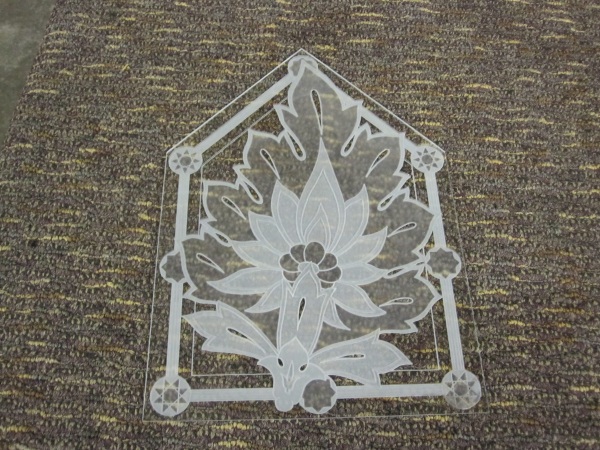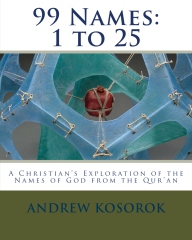99 Names Project Introduction (Part 4)
Some interesting and unintended elements of the process have begun to show themselves. As I struggle to internalize visual elements so I can draw on them from a more emotional level, understanding associated with their use develops. This has been pointed out to me on several occasions when I find myself clarifying ideas expressed by Muslim friends–many Muslims in my area are immigrants, and their command of English and Christian phrases is not always ideal; I can often catch the gist of what my Turkish, Jordanian, or Indian friends are trying to express and give a cultural translation consistent with what they are intending. This meshing of ideas and concepts helps clarify my appreciation for Islamic principles, as I am able to cradle understanding using parallel terms from my own cultural upbringing. After two years in Japan a friend said the most thorough way to appreciate another language is to translate back and forth, and it seems that this is happening on the level of religious symbolism and inference (or people are just too polite to disagree–I certainly hope that is not the case).
Another unintended consistency is the periodic re-emergence of design elements and color in the progression series. As sculptures are developed and designed I draw from Islamic visual elements across many geographic locations and periods of history, with the underlying motivation being that Islam is considered by its adherents as a universal faith, and is not bound by mortal conceptions of time. I avoid direct appropriation, and try to study a pattern or image until I get a “feel” for it, using books on cosmology and philosophy to inform the process (Dr. Critchlow‘s Islamic Patterns: An Analytical and Cosmological Approach, and Dr. Nasr‘s Islamic Art and Spirituality, for examples). At one of the exhibits, it was pointed out to me that sculptures addressing similar themes were sharing points of convergence with color, style, and pattern elements; until then, I was not consciously aware that this was happening. Blue is consistently used as a reference to the bounty of God, because of the rarity and preciousness of water in the Arabian peninsula, and green is used as a marker for the blessings of Divine growth and nourishment, for related reasons; but the specifics of repeated designs and shades of the colors used was serendipitous.
Occasionally, clergy of my own faith have voiced concerns. On hearing my feelings towards the Qur’an one expressed dismay and felt I was betraying my beliefs. Conversely, once in a while a Muslim will communicate surprise that I have not converted to Islam–interestingly, not one who knows me well. The question is a natural one: How can studying another belief system, learning context for symbolism and judiciously looking for fair and appropriate parallels, not have an affect on a person’s faith? The answer is obvious–it can’t; studying other belief systems always impacts a person’s faith. The assumption shared by those communicating their concerns is that the impact is detrimental.
I believe in a Creator; perhaps this is part of my Christian upbringing, or perhaps my Christian upbringing just clarified this belief and gave it deeper structure. Regardless, this belief in a Creator carries with it the assumption that created things have purpose–so, the observation that humans are different leads to the conclusion that they are meant to be different. As a result, a practical assumption is that the spiritual place in which a person is found is a cosmically intended aspect of the person’s unique path. Major belief systems have “protocols” for associating with those not of the particular belief, and the Christian one is simply, “love they neighbor as thyself (Galatians 5:14).” In Islam this concept is contextualized as, “O mankind! We created you from a single (pair) of a male and a female, and made you into nations and tribes, that ye may know each other (not that ye may despise (each other)….(Qur’an 49:13).” The message shared by these two Abrahamic faiths, as I understand it, is: we are different because we are made to be different, and our Creator expects us to grow closer by learning from our differences.
Arun Gandhi, a grandson of Mohandis Gandhi, came and spoke to a group of us concerned with community civility and interfaith connection. He said that his grandfather was commonly asked his faith and his answer was always the same, “I may be Hindu, Christian, Buddhist, Jewish or Muslim, but before I am any of these I am a human.” The fact, as the Qur’an underscores, is that underlying all our differences is our common bond of humanity. In exploring another faith, looking for shared principles and finding appropriate parallels helps explore and strengthen this bond of shared humanity. But what about the differences? Am I diluting my own belief system through the study of another’s, or am I heading towards a future where all belief systems are muddied through their being mixed together? I certainly hope not.
Dr. Alan Bachman has worked tirelessly to show that we can learn about each other without losing our own identities. As Chair of the Salt Lake Interfaith Roundtable, he is in a position to express his sincere admiration and friendship for his multi-faith friends, support many faiths in their unique expressions of belief, and share his personal beliefs about what it means to learn about each others’ differences. In one of his presentations he points out that in every faith tradition, intolerance and inhospitality towards the stranger is a sin, and uses examples drawn from his own Jewish faith. He was challenged in one presentation by an individual who was concerned that this would lead unavoidably to a blending of belief systems, and we would lose our spiritual anchors. “Absolutely not,” Dr. Bachman said, “when we live the teachings of each faith, we rejoice in those things we share, respect our differences, and care for each other as unique creations. When we aspire to the highest principles of our own faith, and live as we are taught, all of us may rise together.” (Continued…)




Mashaa-Allah, all of these are so beautiful! I stumbled across this after uploading some images on my site and your blog was on the suggested reading list…really hope you get to complete all of them, they are stunning.